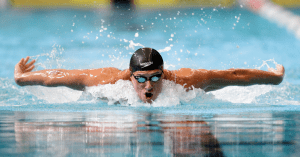Swimming is not only a great way to relax, it can also be a good low-impact way to recover from a strenuous event, writes Tom Heeley.
There are some very common injuries associated with regular swimmers and I want to take a look at them and suggest ways to ease those problems.
Most swimming injuries occur in the shoulder (90%), followed by the lower back and then the knee. Of the shoulder injuries, rotator cuff issues are the most common and lead to the most time lost out of the pool.
Rotator cuff problems usually occur because of reduced flexibility, lack of strength and poor muscle firing patterns. Muscles such as the pectoralis minor and trapezius often end up being short and overactive, whereas muscles such as the serratus anterior and rhomboids are redundant. When this happens, there is often a knock effect to swim length, strength and ultimately pain.
Here we are going to explain some simple ways to lengthen the pectoralis minor and the trapezius muscles as well as strengthen the serratus anterior and rhomboids. This will compliment your swimming, improve performance and help reduce the risk of injuries.
Attempting exercises
If you are already in pain from an injury, please ensure that you seek medical attention for a full diagnosis before attempting these exercises.
Firstly, we need to stretch those muscles which are short and overactive.
The trapezius can be easily self-massaged using an Olympic bar and a squat rack.
Stand with the bar running from front to back, and resting on your trapezius muscle, push up into the bar and create tension on the muscle whilst moving left and right underneath the bar.
If don’t have access to an Olympic bar or squat rack, there is an exercise you can do just sitting in a chair. Sit on your hand with palm down and fingers facing in, sit up tall and take your ear to the opposite shoulder, then begin to look up and down, slowly moving your head as you do so.
Complete both sides with a gentle fluid movement for 30 seconds.
Now I will show you how to strengthen the shoulder with three simple scapular stabilising exercises to help build shoulder stability and strengthen the serratus anterior and rhomboid muscles.
Firstly, get yourself into a press-up position and instead of bending elbows and lowering them to the floor, push through your shoulder blades and take your shoulder blades around rib cage, then sink into the movement and retract the shoulder blades back again.
Secondly, in a three-point row position place a weight in your hand and repeat the process, letting the shoulder blade come around the rib cage and then retract and return the shoulder blade near the midline of the back. Increase the weight as needed but maintain good technique throughout.
Three, place a light Active Kit band around the wrists, then stand against the wall and create a plank position. Take one arm off the wall and “crawl” up the wall. Reaching the shoulders end range then returning back to the starting plank position.
If you can create the time to repeat these exercises up to three times a week, it would be ideal. Good luck.
Read more: The science behind why Active Rollers work so well







